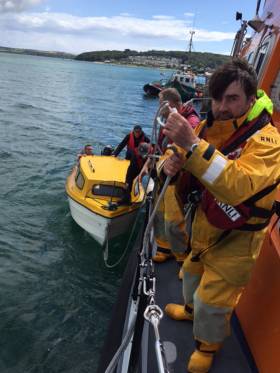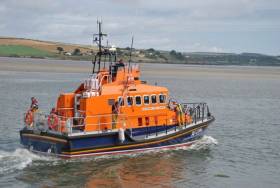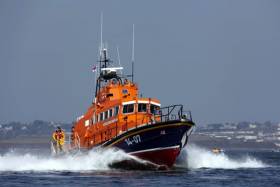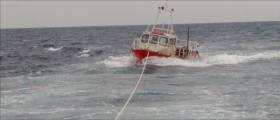Displaying items by tag: Courtmacsherry
Fishing Trip Goes Wrong as 14–Foot Pleasure Craft is Rescued By Courtmacsherry RNLI Lifeboat
The Courtmacsherry RNLI Lifeboat was called out at 11.25 am this morning Sunday to go to the immediate aid of a 14–foot Pleasure boat off Harbour View in Courtmacsherry Bay.
The alert was raised from the shore as the boat was seen to have got into difficulties and was being blown by strong winds towards the coast line.
The Courtmacsherry Lifeboat under Coxswain Ken Cashman and a crew of eight launched both the Trent Class Lifeboat and the Stations Inshore boat and reached the stricken causality within 15 minutes. The pleasure boat, with four persons on board had encountered engine problems and the prevailing winds was putting it in immediate danger.
On scene, the Lifeboat assessed the difficulties with the casualty and secured a tow line to the stricken vessel and then proceeded to tow the boat away from the shoreline and subsequently brought it back to the safe haven of the Courtmacsherry inner harbour.
Conditions at sea today were blustery with Winds in the area blowing force 5/6.
The Crew on board today's callout were Coxswain Ken Cashman with the All Weather Trent Boat crew of Chris Guy, Dara Gannon, Ciaran Hurley, Denis Murphy and Evin O Sullivan. The stations inshore boat was Helmed by Kevin Young and Mark John Gannon.
Courtmacsherry RNLI Lifeboat Station LPO Vincent O Donovan commented, " We are pleased that our Lifeboat was again very fast away today with eight volunteers quickly responding within two minutes and that the rescue was carried out efficiently and very quickly"
He also appealed to all that are using the water over these busy holiday weeks to " take great care of the safety measures associated with your pleasure craft and that Life Jackets are always worn by all persons on board your boat".
#RNLI - Courtmacsherry RNLI's all-weather lifeboat was called out at 11.30am yesterday morning (Wednesday 17 May) to go to the aid of a 70ft fishing vessel that sought assistance 10 miles south east of the Old Head of Kinsale in West Cork.
Under coxswain Sean O'Farrell with a crew of six, the lifeboat launched immediately and reached the stricken vessel at 12.15pm.
The fishing boat, with four people on board, had encountered difficulties with its power and other mechanical failure while trawling in the area and required help.
On scene, the volunteer lifeboat crew assessed the difficulties and took the fishing vessel in tow. Both boats arrived back into Kinsale at 4pm.
Conditions at sea were reasonable, with winds in the area blowing Force 3-4 but rising from early afternoon.
Dermot O'Mahony, Courtmacsherry RNLI deputy launching authority, commented after the callout: “We are so pleased that our lifeboat was again fast away today with our ever ready volunteers always available and that the rescue was carried out with skill and precision.”
Wicklow, Courmacsherry Lifeboats Rescue Fishing Boats In Difficulty
#RNLI - RNLI lifeboats from Wicklow and Courtmacsherry have responded to two separate calls from fishing boats in difficulty around the Irish coast in recent days.
A trawler with three fishermen onboard was towed to safety by Wicklow RNLI yesterday morning (Thursday 10 November) after it lost all power 10 miles offshore.
The all-weather lifeboat, under the command of coxswain Nick Keogh and a volunteer crew, launched shortly after 10am and were alongside the stricken fishing vessel 40 minutes later.
The skipper had dropped an anchor, but it had dragged and the vessel had drifted a short distance south with the tide. Conditions in the area had a slight sea state, with northwesterly winds of Force 2-3 and good visibility.
The Naval Service patrol vessel LÉ Orla and the work vessel Wildcat 2 also stood by the trawler as the lifeboat crew established a towline.
The trawler, with three crew on board, was then towed back to Wicklow and brought safely alongside the South Quay at 12.15pm.
The previous evening (Wednesday 9 November), Courtmacsherry RNLI's all-weather lifeboat was called out at 10.15pm to aid a 65ft fishing vessel in difficulty 25 miles south of the Old Head of Kinsale in West Cork.
The lifeboat, under coxswain Sean O'Farrell and a crew of six, launched immediately and located the casualty at 11.25pm. Conditions at sea were reasonable, with winds in the area blowing 26 knots.
The fishing boat, with three people on board had encountered trouble with its power while trawling in the area and required assistance.
On scene, the lifeboat quickly assessed the difficulties and for the next two hours, the lifeboat and stricken vessel proceeded back at low speed to Kinsale, where the boat was safely berthed at 1.45am.
The crew on board Wednesday night’s callout with O'Farrell were mechanic Stewart Russell, Ken Cashman, Donal Young, Ciaran Hurley, Denis Murphy and Conor Tyndall.
#RNLI - Courtmacsherry RNLI's all-weather lifeboat was called out at 2.45pm yesterday afternoon (Sunday 2 October) as three divers and their support boat sought help as their vessel got into difficulties near Black Head off Kinsale.
The lifeboat was quickly away with a crew of seven and was on scene at 3.15pm to join Kinsale RNLI and the Irish Coast Guard boat from Oysterhaven.
As the divers and their boat were being brought back to shore, another call came from Valentia Radio of an injured crew person on board a sailing vessel off Kinsale Harbour.
Both the Kinsale and Courtmacsherry lifeboats assisted in the transfer of the female casualty to Kinsale Pier, where an ambulance was awaiting to take her to Cork University Hospital.
Conditions at sea today deteriorated from early afternoon with a Force 5 to 6 wind and a strong sea swell.
The cew on the Courtmacsherry lifeboat yesterday were coxswain Sean O'Farrell, mechanic Stewart Russell, Ciaran Hurley, Mark Gannon, Dara Gannon, Dean Hennessey and Evan O'Sullivan.
Courtmacsherry RNLI Lifeboat Rescues Jet Skiers & Pleasure Craft
The Courtmacsherry RNLI All Weather Lifeboat was called out at 5.15 pm yesterday afternoon to go to the aid of three men who got into difficulty in a Jet–ski and small pleasure boat just off the Seven Heads coastline in West Cork.
The Courtmacsherry Lifeboat under Coxswain Sean O'Farrell and a crew of six launched immediately and reached the area at 5.25pm as the three men had overturned in their crafts and were in the water.
The casualties were blown on to dangerous rocks at Seven Heads and the Courtmacsherry Lifeboat succeeded in taking all three men from the rocks and onboard the Lifeboat.
The Coastguard unit from Seven Heads, the Coastguard Rescue Helicopter and The Kinsale RNLI Lifeboat all participated in today's rescue
#RNLI - Courtmacsherry RNLI's all-weather lifeboat was called out at 12.20pm yesterday afternoon (Monday 27 June) to aid a 40ft pleasure cruiser in difficulties just off the Seven Heads in West Cork.
The cruiser, with two people onboard, was on passage from East Ferry to Baltimore when it fouled its propellors about 300 yards off the cliffs at Seven Heads.
Its crew managed to hold themselves off the shore by tying the vessel to lobster pots until the lifeboat arrived. Conditions at sea were windy with a good swell.
The Courtmacsherry lifeboat, under coxswain Sean O'Farrell with crew of six, launched immediately and reached the stricken vessel at 12.45pm, succeeding in quickly getting a tow rope on board the casualty and assessing the damage before taking the vessel under tow to the safety of Courtmacsherry Pier
Naval Service vessel LE Orla also proceeded to the area and stood by with their divers if required.
This was the third similar callout and rescue in the past 10 days for the West Cork lifeboat station.
The Courtmacsherry RNLI All Weather Lifeboat was called out at 2pm today Sat to go to the aid of a 36 foot Fishing Vessel that had got into difficulty just 300 meters off the rocks at Dunworley Point in West Cork.
The Courtmacsherry Lifeboat under Second Coxswain Mark Gannon and a crew of six launched immediately and reached the stricken vessel at 2.28pm and succeeded in quickly getting a tow rope on board the Casuality, which had got into difficulty while fishing and was in danger of going on the nearby dangerous rocks.
With a crew of two on board, the Causality has immediately been taken under tow by the Lifeboat and is expected to arrive back to Courtmacsherry Pier at 3.40pm.
The fishing vessel sent out a Mayday distress call for immediate assistance just as Ireland kicked off the Euro battle with Belgium and the Lifeboat crew were quickly at the Lifeboat station to put to sea.
Conditions at sea today are windy with a difficult swell. Local Angling boat the Lady Louise also assisted in the rescue.
Courtmacsherry RNLI All Weather Lifeboat Called out to Fishing Boat
The Courtmacsherry RNLI All Weather Lifeboat under Coxswain Sean O'Farrell was called out at 11am this morning to go to the aid of a 46 ft fishing vessel that had got into difficulties 14 miles south of The Old Head Of Kinsale in West Cork. The Lifeboat with a crew of seven launched immediately and in very poor conditions, with a sea swell of over 12 feet, they located the Casuality in rough seas.
Immediately they secured a tow line to the casualty and proceeded to tow the stricken vessel back to Kinsale Harbour.
There were four crew on board the fishing vessel. Condition at sea today were poor with heavy swell, high winds and poor visability.
After more than a four hour tow, both boats have now arrived back to the safe surrounds of Kinsale Harbour arriving at just after 4 pm.
Crew on today's call out were Coxswain Sean O'Farrell, Mechanic Stewart Russell and crew Chris Guy, Conor Dullea, Ciaran Hurley, Ken Cashman and Dave Philips.
Courtmacsherry Lifeboat In Callout To Swimmer Off Kinsale
#RNLI - The Courtmacsherry RNLI all-weather lifeboat was called out at 2.20am this morning (Monday 7 September) to go to the aid of a swimmer that had got into difficulty in a dangerous rip current off Garrettstown Strand near the Old Head of Kinsale in West Cork.
The lifeboat, under coxswain Sean O'Farrell and a crew of six, were away very quickly and proceeded at pace to the location of the incident. Also tasked were the coastguard unit from the Old Head of Kinsale and the Irish Coast Guard helicopter from Waterford, Rescue 117.
As the lifeboat arrived on scene within 15 minutes, under the cliffs off Garrettstown Strand, the crew used their searchlights to light up the area.
The swimmer got ashore and, with the assistance of the Old Head Coast Guard Unit, was transferred to the coastguard rescue vehicle until the HSE ambulance and Rescue 117 arrived. The casualty was then transferred by ambulance to Cork University Hospital.
It was a busy 12 hours for Courtmacsherry RNLI as earlier on Sunday evening (6 September) at 6.25pm, it was tasked by Valentia Coast Guard to go to an area where two kayakers were reported to be in difficulty off the Seven Heads in Courtmacsherry Bay.
A member of the public had reported the incident and again the lifeboat with a crew of seven were away in minutes.
They carried out an extensive search of the Seven Heads coastline and it was soon established that the kayakers had got ashore safely.
Speaking on the Strand in Garrettstown this morning, Courtmacsherry RNLI lifeboat operations manager Brian O'Dwyer said: "I want to say a hugh thanks to the fast response of the lifeboat crew and all the rescue services who rose from their beds quickly at 2.20am this morning to respond to a potentially very dangerous incident here off Garrettstown.
"We had enough for two volunteer lifeboat crews responding within minutes and great credit is due to these, who always respond immediately whether the call is by night or day and in all types of weather condition, when the lifeboat pagers alert them."
Courtmacsherry RNLI Respond To Third Call-Out In 12 hours
#courtmacsherryRNLI – For many it was the end of the working week, but for members of the Courtmacsherry RNLI All weather Lifeboat Crew, yesterday evening was only the commencement of a very busy period of activity at sea, as it has now responded successfully to three rescues off our shores writes Vincent O' Donovan.
The All weather Trent Class RNLI Lifeboat was called out again this afternoon Sat at 3.50pm to respond to a Mayday call from a 55ft Fishing vessel that encountered difficulities just 2 miles south of the Old Head Of Kinsale in West Cork. In fresh winds blowing Force 5, with a two meter swell, the Lifeboat was away within minutes and located the casuality at 4.25pm and immediately secured a tow line. It has now brought the vessel under its control and is proceeding to tow the fishing boat, with six crew on board back to Kinsale harbour. As conditions at sea this evening are poor, its estimated time of arrival into Kinsale is 6.30pm.
Today's callout follows last evening rescue of a 60ft fishing vessel two Miles off The Seven Heads coastline which had got into difficulties at 5.40pm with 5 crew on board.As that Fishing vessel was safely berthed at Courtmacsherry Pier last evening at 8.45pm, an emergency call was received from Valentia Coastguard, that a large dog had fallen off the high cliffs at File Na Mho, near Broadstrand in Courtmacsherry Bay and that the owner who had tried to climb down the cliff to retrieve it, had failed and was in danger himself. The owner alerted the rescue Services through a 999 call and immediately, the Courtmacsherry Lifeboat responded. Within minutes at 8.50pm, the Lifeboat arrived at the Base of the cliffs and using its powereful engines and spotlights, located the stricken dog on the rocky waters edge.
Using its inflatable punt two members of the Lifeboat crew in special RNLI Lifeboat wetsuits suceeded in securing the Large Rhodesian Ridgeback and brought it to the safety of the Lifeboat, while the powerful Lifeboat Searchlights guided its owner to safety at the cliff top.
Twenty minutes later the owner and the large dog were both reunited in safety at the Lifeboat Station.




































































